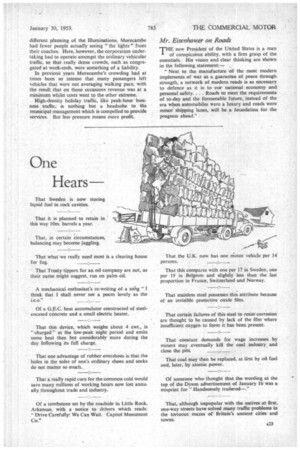Passing Comments
Page 100

Page 101

If you've noticed an error in this article please click here to report it so we can fix it.
Is This the Biggest ?
THERE have been many suggestions as to what is I the biggest pneumatic tyre in the world; this honour, it seems, must go to a product of the Firestone concern of America. It is 10 ft. high, 4 ft. wide, tubeless, and operates at an air pressure of only 10-15 lb., but even at this it can carry a load of 8 tons, the tyre itself weighing a little over 131 cwt. It was designed for the Le Toui-neau "Swamp Buggy."
Tinned-glass Screens
A YEAR or so ago, reference was made in this " journal to surface-conductive glass. Further information concerning this shows that the glass is impregnateil with certain tin components, such as by exposing it during annealing to the vapour of stannic chloride. At first used as a decorative finish, it was later found that the insulating value of the glass surface was reduced.
As a result of this, in the types at present made and considering any square area of the glass, if this be placed under a potential of 110 volts, a current of 0.88 amp. will pass over its surface—the equivalent of 96.8 watts. The heating effect will vary according to the area concerned. If this was 1 sq. in. the glass would melt.
For heating, say a glass windshield of moderate size, the heat dissipation required would be 500 watts per sq. ft. This would mean an applied voltage of
A22 about 150. For windscreens, a safety laminated glass is used, the conductive surface being within the sandwich, so that the danger of electric shock is avoided. The bonding to the plastic interlayer is durable and the safety value of the glass not lost. What is more, the film does not seem to affect the transparency, whilst the treated surface is harder and more resistant to abrasion.
Contact with the film at the opposed edges is made by painting on and firing a silver composition. To the silver film thus formed is soldered copper foil, or metal can be sprayed on to it.
Less Pressure, More Profit
THE general experience among seaside resorts I where illuminations were staged last autumn appears to have been that ordinary week-night traffic was considerably less dense than in previous years. Whilst this trend has meant a reduction in the volume of potential passengers, conditions have generally made operation more economical for, as with business-hour travel in major centres, a slackening of pressure has permitted a vehicle to accomplish more trips in a given time. Furthermore, higher speeds have brought greater patronage.
Outstanding among the resorts that literally were "all lit up" were Blackpool and Morecambe. Although the former had trams with a separate track along the sea front, special arrangements, which were described in "The Commercial Motor" of October 24, had to be made to deal with the visiting coaches. Owing to different planning of the Illuminations, Morecambe had fewer people actually seeing "the lights" from their coaches. Here, however, the corporation undertaking had to operate amongst the ordinary vehicular traffic, so that really dense crowds, such as congregated at week-ends, were something of a liability.
In previous years Morecambe's crowding had at times been so intense that many passengers left vehicles that were not averaging walking pace, with the result that on those occasions revenue was at a minimum whilst costs went to the other extreme.
High-density holiday traffic, like peak-hour business traffic, is nothing but a headache to the municipal management which is compelled to provide services. But less pressure means more profit
Mr. Eisenhower on Roads
THE new President of the United States is a man of conspicuous ability, with a firm grasp of the essentials. His vision and clear thinking are shown in the following statement:— " Next to the manufacture of the most modern implements of war as a guarantee of peace through strength, a network of modern roads is as necessary to defence as it is to our national economy and personal safety. . . . Roads to meet the requirements of to-day and the foreseeable future, instead of the era when automobiles were a luxury and roads were minor shipping lanes, will be a foundation for the progress ahead."
























































































































































